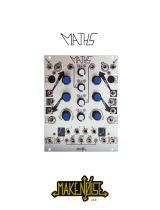
4. {MIDI B CV source}: PGM_A = <ON>, MIDI_B = <PULSES>
• PGM_B = <OFF> – Note number
• PGM_B = <ON> – Velocity (default)
• PGM_B = <PULSE> – Mod Wheel
• PGM_B = <FLASH> – LFO ([TAP] PGM_A twice or more to set frequency). This is a Triagle wave LFO with user-dened
frequency.
Note gives you the ability to use the 0-Coast as a MIDI-to-CV converter for external voltage controlled synths, or to emulate
"key-tracking" behaviors found on monosynths. For example, patch the MIDI_B CV to BALANCE CV INPUT in order to have the sound get
brighter as the notes go higher (adjust the Balance combo pot further clockwise for more dramatic eect). The Overtone and Multiply
settings will determine the maximum brightness. The Simple Bass patch on p.37 is a good starting point. Using this setting along side MIDI
A, you could drive an additional VCO or voice, whether in an external modular or other CV controlled synthesizer, or using the 0-Coast's
SLOPE circuit as a VCO.
Velocity can be used to change the timbre of notes depending on how hard they are played, for example patch MIDI_B CV to
MULTIPLY to brighten notes that are played harder. Mod Wheel provides an extra manual modulation source to any parameter. If using a
DAW such as Ableton Live, you could use this to automate a Modulation Track. The LFO option is a Triangle Wave whose frequency is set
by [Tapping] PGM_A when not in the Program Pages.
5. MIDI B Gate Source: PGM_A = <ON>, MIDI_B = <FLASHES>
• PGM_B = <OFF> – Gate goes High with Note = <On>
• PGM_B = <ON> – Gate goes High when Velocity > 50%
• PGM_B = <PULSE> – Gate goes high when Mod Wheel > 50% (Default)
• PGM_B = <FLASH> – LFO ([TAP] PGM_ A). This is a square wave LFO with User-dened frequency.
Setting this parameter to Note allows for a new Gate to be generated with each new Note. This is useful for ring the Slope
generator with each note, or clocking the Stepped Random output, to generate a new random value with each note. Keep in mind that
the Gate’s behavior, when Notes overlap, is aected by the Legato setting from PGM page 2. In conjunction with MIDI B Pitch CV, this
setting is useful as a gate source for a second voice or instrument.
The Velocity and Mod Wheel options cause the Gate to go High when the selected parameter is above 50%. This is useful for
emphasizing louder notes or manually switching between parameter settings. The LFO is a Square Wave, and shares the same rate as the
MIDI B CV Triangle LFO, set by <Tapping> PGM_A.
6. MIDI Clock: PGM_A = <FLASHES>
• PGM_B = <OFF> - OFF (Default)
• PGM_B = <ON> - 1/1
Tempo follows the rate of the incoming MIDI clock. The Tap Tempo and TEMPO Input are added together with the MIDI clock.
7. Calibrate: MIDI_A & MIDI_B = <ALTERNATE>, PGM_A =<ON>, PGM_B = <OFF>
• [PRESS] PGM_B in order to Calibrate (Note: it takes 3 to 6 minutes). This procedure calibrates the MIDI_A CV Converter,
which is connected internally, to the Voltage Controlled Oscillator. If connected, it will also calibrate the MIDI_B CV
Converter.
The 0-COAST arrives fully calibrated. There is no need to run the calibration routine unless you are trying to recali-
brate MIDI_B CV to drive a device that does not track 1V/ Octave such as the 0-COAST SLOPE circuit, or it has been
recommended to you by Make Noise technical Support to do so. Before running either calibration procedure, be sure
the 0-Coast has been powered up for at least 20 minutes without interruption. Disconnect MIDI and all patch cables
from the 0-COAST.
• To Calibrate internal VCO only, adjust the grey Pitch Panel Control Full Counterclockwise, then adjust the Fine frequency to
10:00. [Press] PGM_B to run the calibration, which takes about 3 minutes. Once the procedure has begun, do not adjust any
parameters on the 0-Coast. During calibration, the PGM_B LED stays ON. MIDI A and exits the Program Page and return to
normal operation with the Clock and Stepped Random Activity Windows on.
• To Calibrate to an External VCO, patch a basic waveform, such as Sine, Square or Saw Wave, to the 0-Coast TEMPO input.
Patch MIDI_B CV to the 1V/Oct Pitch input on the external VCO. Again, adjust the 0-Coast Pitch Panel control Full
Counterclockwise and adjust the Fine-tune control to 10:00. Now, adjust the External VCO’s Pitch Panel Control(s) until the
PGM_B Button LED turns <ON>. [PRESS] PGM_B to begin the Calibration. Once the procedure has begun, do not adjust any
parameters on the 0-Coast or the External VCO. During calibration, the PGM_B LED stays ON. MIDI A and MIDI B Activity
Windows, PGM_A LED, TEMPO LED and Random Voltage
LED are OFF. When calibration has nished, the 0-Coast exits the Program Page and returns to normal operation with
the Clock and Stepped Random Activity Windows lighting. This process calibrates the 0-Coast’s MIDI_B CV Output to
accurately track with an External VCO and takes about 6 minutes.
14

























